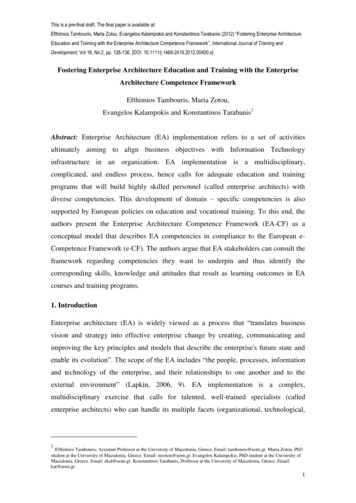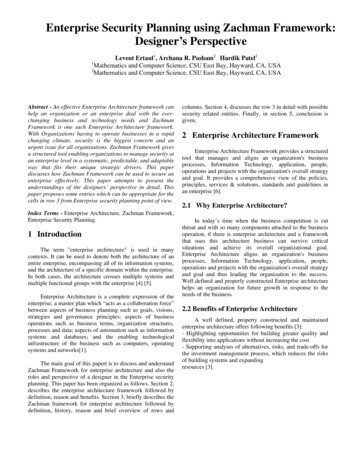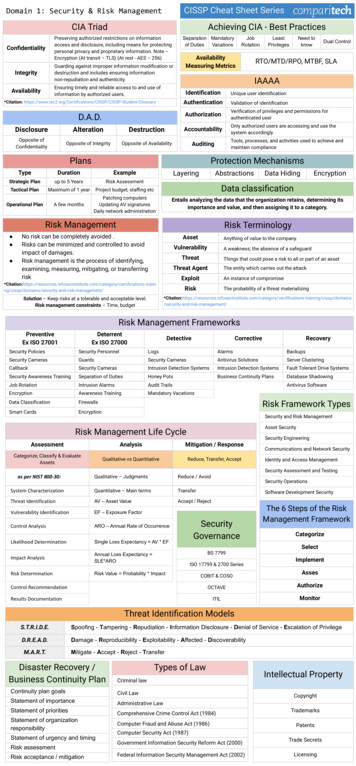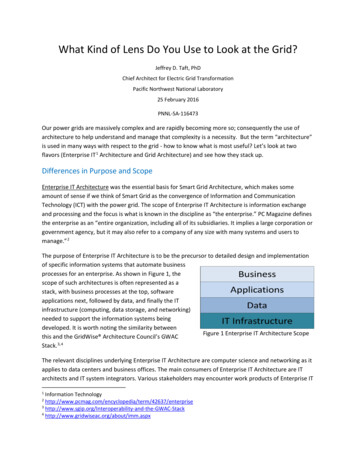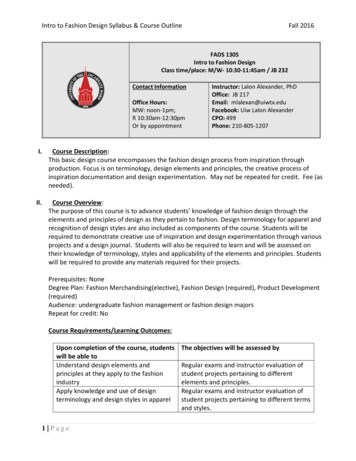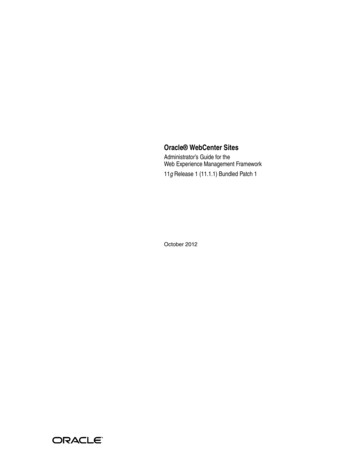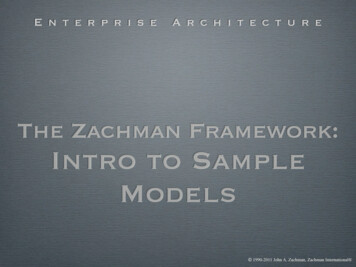
Transcription
E n t e r p r i s eA r c h i t e c t u r eThe Zachman Framework:Intro to SampleModels 1990-2011 John A. Zachman, Zachman International
ObservationEnterprises areCOMPLEXThe US PentagonGM Plant 1990-2011 John A. Zachman, Zachman International
AgendaI. Enterprise Models from LiteratureII. Implementation DiscussionIII. Architecture DiscussionIV. Column 1 Model SamplesV. Row 1 Model SamplesVI. Column 2 Model SamplesVII.Etc., Etc. ‘till Time Is Up 1990-2011 John A. Zachman, Zachman International
Models on my Bookshelf1. "Requirements Analysis" by David C. HayActivity ManagementA Complete Sarson and Gane Data Flow DiagramPhysical AssetValue Constraints2. "Information Modeling and Relational Databases" by Terry Halpin and Tony MorganIT Company Schema and University Schema3. "Enterprise Architecture for Integration" by Clive FinkelsteinStrategic Model for sample solutionOrder entry data map with all attributes5BNF data map - ORG and ROLE STRUCTURES4. "Designing Quality Databases with IDEF1X Information Models" by Thomas A. BruceCase Study Supplementary Material (Logical Data Model)5. "Business Process Management"by Roger T. BurltonThe Scope for Global Software Human Resources 1990-2011 John A. Zachman, Zachman International
Models on my Bookshelf6. "Enterprise Architecture at Work" by Marc LanghorstServices provided by Handle Claims ProcessHandle Claims and IT Support7. "Business Process Engineering" by August ScheerERM for Human Resource PlanningEvent-driven process chain for inbound logistics8. "Data Model Resource Book" by Len SilverstonWork effort invoicingWork order and work order effort model9. "Workflow Modeling" by Alec SharpHand-off level diagram for a to-be processMilestone level diagram for a to-be process10."The Practical Guide to Structured Systems Design" by Meiler Page-JonesCase study DFD (excruciating detail and high level of detail)11."The Object Advantage" by Ivar JacobssonThe use cases and actors in our final modelThe flow of events in a use case12."Mainstream Objects" by Ed Yourdon et alSeminar registration system - object structure 1990-2011 John A. Zachman, Zachman International
Models on my Bookshelf13."Business Process Improvement" by H.J. HarringtonRelating external customer expectations to process14."Industrial Dynamics" by Jay W. ForresterSubdivisions of the model, interconnections .Continuous balance sheet at factory15."Kaizen" by Masaaki ImaiQuality Assurance Systems Diagram16."Strategy Safari" by Henry MintzbergAnnual Planning Cycle at General ElectricStanford's proposed 'System of Plans'17."The Fifth Discipline" by Peter M. SengeCodependency archetype18."Competing Against Time" by George StalkOrder flow logistics - Location of DepartmentsOrder flow logistics - Departments19."Competitive Advantage" by Michael E. PorterValue Chain20."Building Enterprise Information Architectures" by Melissa A. CookBallpark view process classesBallpark view global data classes 1990-2011 John A. Zachman, Zachman International
Models on my Bookshelf21."Systems Analysis and Design Methods" by Jeffrey L. Whitten and Lonnie D. BentleyMember Services Fully Attributed Data ModelA (Process) Systems DiagramDetailed Location Connectivity DiagramMember Services Use Case Model DiagramThe End Product of Structured DesignActivity Diagram for the Procurement PhaseStar Networks and Hierarchy networksSample Physical Data flow DiagramSample System FlowchartNetwork Topology Data Flow DiagramData Distribution Across the NetworkPhysical DFD Design Unit for an EventSoundStage Logical Data Model - 3rd Normal FormPrototype for New Video Title ScreenTypical External Turnaround DocumentEfferent Portion of Structure ChartSoundStage DFD Reflecting Central TransactionSoundStage Structure Chart from Transaction AnalysisDFD with Transaction Center/Structure ChartSoundStage DFD Reflecting Transaction CenterSoundStage Structure Chart from Transaction AnalysisInteraction Diagram for Order use CasePartial Object Model for Use Case 1990-2011 John A. Zachman, Zachman International
Models on my Bookshelf22.Enterprise Architecture Planning - Actual Example By Doug Erickson, ENTARCOEnterprise Motivation ModelLogical Business Process ClassesBusiness Entity ClassesLogical Processes vs Data Classes matrixLogical Business Units vs Organization Units MatrixLogical Business Units vs Logical Business Processes MatrixLogical Business Units vs Logical Business ProcessesLogical Business Units vs Data Classes MatrixLogical Business Process Data Dependency Chart23.Enterprise Architecture Methodology - Examples by Doug EricksonEnterprise Conceptual Data ModelEnterprise Conceptual Data Model - AttributedEnterprise Conceptual Process Model24.etc. etc. etc. 1990-2011 John A. Zachman, Zachman International
CompositesAll of these example Enterprise models are good, relevant,useful, valuable, helpful for building automated and manualsystems, analyzing problems, proposing solutions, etc., etc.,Necessary for doing actual Enterprise work. 1990-2011 John A. Zachman, Zachman International
CompositesAll of these example Enterprise models are good, relevant,useful, valuable, helpful for building automated and manualsystems, analyzing problems, proposing solutions, etc., etc.,Necessary for doing actual Enterprise work.They are ”descriptive representationsmodels of an Enterprise 1990-2011 John A. Zachman, Zachman International
CompositesAll of these example Enterprise models are good, relevant,useful, valuable, helpful for building automated and manualsystems, analyzing problems, proposing solutions, etc., etc.,Necessary for doing actual Enterprise work.They are all:How many other site”useful,“views”valuable,descriptive representationshelpful modelsmodels of an Enterprisecould you find? 1990-2011 John A. Zachman, Zachman International
Which is Best?Which sample model was the best one?I submit, the model needed will depend upon:1.The work to be done2.The skills, creativity, experience, culture of the worker3.The state of the art, available descriptive technology4.The Enterprise data availableetc.In short, there is not one kind of relevant model . the kinds ofrelevant models are virtually infinite and not likely predictableuntil needed and created. 1990-2011 John A. Zachman, Zachman International
Enterprise ArchitectureThe idea of Enterprise Architecture is to discover the underlying, elementary,"primitive" components from which any relevant, unpredictable, "composite"model can be created:for any given Enterpriseat any given point in timefor any given kind of workby any given person.Humanity, for the last 7,000 years has proven this architectural idea and theolder disciplines of:Architecture and Construction, andEngineering and Manufacturinghave tested the proof for the last 300 years.The Zachman Framework for Enterprise Architecture 1990-2011 John A. Zachman, Zachman International This might not be as hard as you think . because it is possible to identify thebasic set of elementary Components that exist, that can be described and fromwhich any "composite," "view" (Model) of an Enterprise (or for that matter, forany industrial object) can be created.
1990-2011 John A. Zachman, Zachman International
This is Really SimpleThe contents of any category, class (Framework Cell) of generic components("Primitives") is composed of two and only two different kinds of things . (1)the generic component itself and (2) its relationship with all other genericcomponents of the same type. For example:The other dimension of the two dimensional classification system are thestages of Reification . transformation of ideas into reality:Row 1: Identification (Names, Boundaries Clarified)Row 2: Definition (Concepts, Semantic Structures Defined)Row 3: Representation (Logic, Concepts Systematized)Row 4: Specification (Physics, Technology Constrained)Row 5: Construction (Tooling Configured)Row 6: Instantiation (Reality Created) 1990-2011 John A. Zachman, Zachman International Col. 1: Inventories (Entities) and Counts (Relationships)Col. 2: Transformations (Processes) and Inputs/Outputs (Flows)Col. 3: Locations (Nodes) and Connections (Links)Col. 4: People (Skills) and Assignments (Work Products)Col. 5: Cycles (Durations) and Moments (Points in Time)Col. 6: Ends (Objectives) and Means (Strategies)
Elegance of PrimitivesThe elegance of a Primitive, single variable model is:1. Enterprise-wide models - only one kind of thing in the Enterprise modelreduces the complexity immeasurably and the model can be tested forcompletion.2. "Net Set" - extraneous components can be eliminated producing a minimal,optimal, Enterprise model.3. Correct - structure of the model supports the intent and the operation of theEnterprise. Composite models created through using (or re-using) Primitivecomponents, by definition, will be "aligned".4. Flexible - separation of independent variables allows Primitives to bechanged independently from one another, changes to a Primitive becomes a"delta" and change impacts on other Primitives through 'integrations' (i.e.Composites) can be predicted.5. Reduced "Total Cost of Ownership" - eliminates discontinuities, Entropy,through "normalization" of Primitives - Reduced General and Administrativecosts of Enterprise operations.6. Instances are traceable to every Reification Stage. 1990-2011 John A. Zachman, Zachman International
Enterprise Entropy"Entropy: 1 a: a measure of the unavailable energy in a . system that is also usuallyconsidered to be a measure of the system's disorder. 2 b: a process of degradation orrunning down or a trend to disorder. 3: CHAOS, DISORGANIZATION,RANDOMNESS."Mirriam-Webster's Collegiate DictionaryThe Mythical Man-Month by Frederick P. Brooks"All repairs tend to destroy the structure, to increase the entropy and disorder of thesystem. Less and less effort is spent on fixing the original design flaws; more andmore is spent fixing flaws introduced by earlier fixes. . Although in principle usableforever, the system has worn out as a base for progress. Furthermore, machineschange, configurations change, and user requirements change so the system is not infact usable forever. A brand new, from-the-ground- up redesign is necessary. ."Systems program building is an entropy-decreasing process hence inherentlymetastable. Program maintenance is an entropy-increasing process, and even its mostskillful execution only delays the subsidence of the system into unfixableobsolescence."Note: The Second Law of Thermodynamics 1990-2011 John A. Zachman, Zachman International
RedundancyThere are two problems with redundancy:1. Spending money that doesn't have to be spent2. Entropy. (If the same concept exists more than once but is not definedconsistently . or if the inventory record values don't agree: Disorder,Discontinuity.)Disorder, discontinuity requiresreconciliation, compensation, cross-references, interfaces,"work-arounds", MBA's with Excel Spreadsheets, etc., etc.to continue operations . or the urgent case,to prevent failure.EntropyEntropy, General & Admin. Costs, Indirect Expenses costs (lots of) money andincreases over time!When the cost of Enterprise operations exceeds the Enterprise valuecontribution, the Enterprise becomes dysfunctional (extinct). 1990-2011 John A. Zachman, Zachman International
Total CostIt is not adequate to value a system (any implementation) based on itsdevelopment costs and implemented benefits alone.You need to look at the "Total Cost of Ownership"(maintenance and replacement) andTotal Cost of Ownership in the context ofTHE ENTERPRISE.If any one system implementation creates redundancies(discontinuities) with existing systems (legacy) or futuresystems (project slate) there WILL beENTERPRISE ENTROPYto BEGIN WITH.So: how do you reduce Entropy?Reduce disorder.So: How do you reduce disorder?Reduce Redundancy. 1990-2011 John A. Zachman, Zachman International
RedundancySo: How do you reduce redundancy (i.e. Make it LEAN)?(If this was easy, it would already be done!!)(I submit . we can't even FIND the redundancies.)(Because everything is instantiated as COMPOSITES!)There are two possibilities:1. Rebuild the systems, ground-up . modernize. (Re: Fred Brooks)2. Architect the Enterprise so redundancies andinconsistencies can't be created in the first place. (Re: JAZ - Enterprise Architecture)So .How do you even FIND the redundancies?A. Enterprise-WIDE models.B. Single variable, PRIMITIVE ModelsPRIMITIVE MODELSWe are not trying to do implementations with Primitive models. We are trying toidentify and optimize the non- redundant, "net" set of Enterprise components fromwhich any Enterprise implementation composite can be created dynamically,addressing the "Total Cost of Ownership". of THE ENTERPRISE. 1990-2011 John A. Zachman, Zachman International
Please NoteI never said, "Stop the music for 15 or 20 years and build out all the PrimitiveModels before you can do any more implementations or actual work!I DID say,"someday, SOMEDAY, you are going to wish . "In fact I said "Forget YOU, someday, THE ENTERPRISE is going to WISHthey had all the Primitive models made explicit, all of them Enterprise-wide, allof them horizon- tally and vertically integrated and all of them at excruciatinglevel of detail!Why?: It would be LEAN AND MEAN ! However, and furthermore, I AMsaying that any implementation (system) you build that is not derived by reusing components from Primitive Models may well be implemented . butNOT Architected, certainly notENTERPRISE-Architected.It is going to be . more "legacy".Think about the last 75 years or so. Have we ever built anything other than"legacy." What has changed? 1990-2011 John A. Zachman, Zachman International
Please Note Again!I NEVER said, "Don't build any more systems!!!"Notice:The short term demand is NOT going to go away! There is substantive value toimplementing a system. Systems are better, faster and cheaper than people.New technologies open up new opportunities.Problems must be solved!etc., etc.However, I AM saying, "if all you are doing is building and running systems,what do you think you are going to end up with at the end of the day?SYSTEMS!a "Legacy" by whatever name it is called !And I don't care how fast your hardware is or how new your operating systemis or how clever your programmers are. You are NOT going to end up with acoherent, optimal, flexible, integrated, aligned, lean & mean ENTERPRISE!You are going to end up with more LEGACY! 1990-2011 John A. Zachman, Zachman International
ObservationsSo far, few people have made really serious efforts to discover the underlyingEnterprise Primitives from which implementation Composites could becomposed.Maybe the one notable exception that most people would acknowledge as aworthy endeavor would be the Inventory Structures C1 Primitives (theEnterprise Entity R2 or "Data" R3 Models) which, if they were created, couldbe re-used in more than one implementation .which is the very concept of ALL of the Primitives.It is interesting . the great preponderance of books on systems or any kind ofmodeling on my bookshelf have a discussion on "Entity Models", or "DataModels".But even at that . we seem to have this uncontrollable urge to imbed otherPrimitive components (like Processes) into the Entity ("Data") Model becausethat's what we want for implementation purposes, making it into animplementation model, a "Composite". 1990-2011 John A. Zachman, Zachman International
Observations No. 2Forget the Primitives for a moment . and forget "Total Cost of Ownership".Another reason why few people have made serious efforts to do EnterpriseArchitecture is because, by its very name, it implies, Enterprise-WIDEArchitecture. And,1. It would take too long and cost too much!2. You don't need Enterprise-Wide models to get some one system built .and deliver Enterprise BENEFIT!! (Immediate gratification.) And .the smaller you make the systems, the faster you can deliver them.3. Enterprise-wide would be soooo complex, who could understand it .even if you could build it?4. To simply build them and understand them, they would have to be soabstract they would have little value. They couldn't be correlated withimplementations.Here is the real problem . the underlying assumption in all the above is:Enterprise-Wide COMPOSITE Models. And, the only practical solutionunder this assumption is to decompose, build smaller pieces (addingredundancy, adding discontinuity, DIS-integrating the Enterprise), buildingmore LEGACY. 1990-2011 John A. Zachman, Zachman International
BUT PRIMITIVE MODELS!IF you have only ONE kind of thing in each Model,andIF those one things are unitary concepts .NOT complex, composite constructs,andIF those unitary things are precisely defined by a twodimensional schema, an Ontology (like the Periodic Table),andIF you manage the inventory of those things you create,THENEnterprise-wide models become a feasibility.Complexity is reduced immeasurablyandYou can build Primitive Models out "sliver" by "sliver" over some long period of time,controlling discontinuity (dis-integration) by controlling redundant creation of theunitary concepts, you are designing for change (separating independent variables)ANDIf you build more than one Primitive Model, you cancreate Composite implementations as you go. 1990-2011 John A. Zachman, Zachman International
Why Enterprise Architecture?Reduce Enterprise Operating Costs, General and Administrative costs,make the Enterprise LEAN. Minimum possible cost of operations.Enterprise Design Objective: INTEGRATIONReduce the time, disruption and cost of Enterprise Change.Enterprise Design Objective: FLEXIBILITYEnsure Enterprise operations reflects the intentions of ManagementEnterprise Design Objective: ALIGNMENTMake the Enterprise "MEAN" - Reduce response time to external demands.Enterprise Design Objective: REUSE, MASS-CUSTOMIZATIONEnable the Enterprise to "interoperate" with other Enterprises outside of itsjurisdictional control.Enterprise Design Objective: FEDERATED ARCHITECTURE 1990-2011 John A. Zachman, Zachman International
Complete Set of SamplesFor the complete set of sample Primitive Models go to:www.sybase.com/zachmanDavid Dichmann of Sybase PowerDesigner has mapped themetamodel of PowerDesigner against the metamodel forENTERPRISE ARCHITECTURE(The Zachman Framework)All of my sample models are resident in the tool and can be seen inthe Zachman Plug-in for PowerDesigner demo. 1990-2011 John A. Zachman, Zachman International
Complete Set of SamplesDavid Dichmann demonstrated at the Enterprise Architecture Conference inLondon in May 2010 that Sybase PowerDesigner behaves as prescribed by theFramework schema including:Creating pure Primitive Models Creating Composite implementationsfrom components of PrimitivesMaintaining horizontal integrative relationships across the Rows andvertical transformational relationships down the ColumnsMaintaining traceability relationships from instances in Row 6 to eachCell in each ColumnPlus various applications including impact analysis, configurationmanagement, versioning, reverse engineering, etc.I hope this is merely the first of ALL modeling tools to support EnterpriseArchitecture because until we, the information community, can agree, like theolder disciplines of Architecture and Construction and Engineering andManufacturing as to what constitutes standard descriptive representations ofcomplex objects, we are relegated to building systems, more of the same IT"legacies" . NOT ENTERPRISES. 1990-2011 John A. Zachman, Zachman International
Enterprise-wide models - only one kind of thing in the Enterprise model reduces the complexity immeasurably and the model can be tested for completion. 2. "Net Set" - extraneous components can be eliminated producing a minimal, optimal, Enterprise model. 3. Correct - structure

